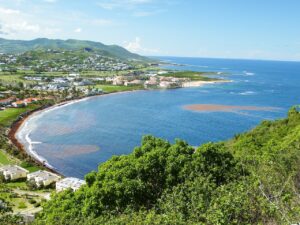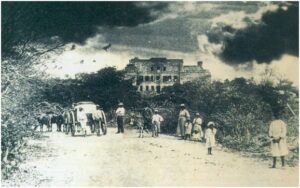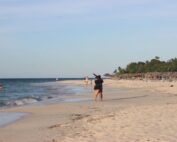Special TTC: Saint Kitts and Nevis, the origins of tourismo in the Caribbean

Saint Kitts and Nevis. Photo: Pixabay/mickfromsvg
By: Jose Luis Perelló
The first Europeans to land on the Caribbean islands of Saint Kitts and Nevis (St. Kitts & Nevis) were the Spanish, who spotted them on November 11, 1493 during their second voyage. However, European colonization began in 1623, when first the English and then the French arrived on the island of San Cristóbal, whose name was shortened by the English to St. Kitts Island. Because it was the first English colony in the Caribbean, St. Kitts served as a base for the future expansion of English colonization of the region.
The two islands are separated, about three kilometers, by the Narrows Strait, and the highest elevation is Mount Liamuiga at 1,156 meters on St. Kitts, the islands’ highest.
The territory of Nevis, already colonized by the English in 1628, grew prosperously under British laws. The Treaty of Versailles in 1783 returned both islands definitively to Great Britain. The islands were part of the Leeward Islands colony from 1871 to 1956, and the West Indies Federation from 1958 to 1962.
In 1967, together with Anguilla, it became part of the British Commonwealth, becoming part of the British Overseas Territories. The federation of Saint Kitts and Nevis achieved complete independence on September 19, 1983.
It is the smallest country on the American continent, both in size and population. Saint Kitts and Nevis have a land area of 261 square km and a population of almost 48,000 inhabitants. Its capital and most populated city is Basseterre, in Saint Kitts.
In 1776, St. Kitts & Nevis had become the richest British colony in the Caribbean, receiving the first travelers from the old continent, who had their roots in England in the mid-18th century, when the idea among the British aristocrats of what they called the “Grand Tour” (and those who carried it out were, therefore, ‘tourists’). A trip reserved for the wealthy classes, because it lasted months, and it was necessary to have a sufficiently well-off economy to be able to have money during that time.
Taking advantage of the flow of travelers to the colony and adapting to the needs and fashions of the time, John Huggins built the first tourist hotel in the Caribbean in 1787 (according to Christine Eickelmann): the Bath House-Hotel, which was built on a site of the famous thermal springs on the island of Nevis, Bath Spring.
The island thus became the first place in America to officially practice tourism. As a result, Nevis’s popularity as a destination grew, and it remained favored by the British upper classes, such as Samuel Taylor Coleridge, Lord Nelson and Prince William Henry, until it closed in the 1870s. The hotel opened briefly from 1910 until the 1930s, after being renovated by the Gillespie brothers.
Bath House-Hotel and Bath Stream-Spring represent a unique cultural heritage landscape, encompassing a distinctive heritage of health, wellbeing, resort, recreation and tourism.

Bath House-Hotel
The original owners of the Bath House-Hotel envisioned the invention and inception of a Caribbean tourism industry for decades, and a transhemispheric vision of that industry for nearly a century, through a continuous review of the site’s intention to encompass both spa and health tourism, and tropical recreational and leisure tourism. This makes it the first intentional, tourism-focused Resort and Hotel Spa, imagined and designed for the Caribbean. Its history is also a remarkable and continuing testimony to the aspirations and identity of Nevis over the last two centuries, despite hardships and the many significant social, economic and natural changes that might otherwise have brought an end to its history during that time.
Currently, St. Kitts & Nevis is a tourist destination in the Insular Caribbean that receives an average of one million tourists and thousands of cruise passengers. Its main cities Basseterre, Charlestown, Saint Paul’s and Sadlers; and a diversity of territories makes it possible to expand the tourist offer beyond the attractions of sun and beach. It offers ecological excursions and climbing activities; and also has cultural tourism offerings with more than 200 places of historical interest with accommodation in the former plantation houses.
It is an important destination in the region, with a tourist infrastructure with more than 60 4- and 5-star hotel facilities belonging to the main U.S. and European international hotel chains. A vast and varied offer that includes magnificent beaches, interesting architecture and various cultural events that take place throughout the year. Car, van and jeep rentals are also offered, as well as bus service that travels the island’s routes.
Tourists mainly come from the United States (50%), Europe (8.2%) and Canada (6.2%); with an average stay of 10 days. It has two international airports managed by the state entity Ports and Airports Authority. On the island of Saint Kitts there is the Basseterre Port, whose infrastructure capacity can accommodate the largest cruise ships in the world, and the Zante Port; and on the island of Nevis is Port Charlestown.
Source: The History & Archeology of the Bath House-Hotel and Bath Stream-Spring Landscape, Nevis. Report Prepared for the Nevis Historical & Conservation Society.

MORE NEWS










